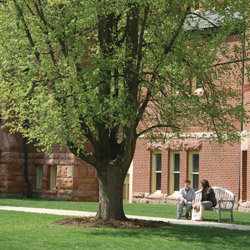
What’s the best college in the Midwest? What university provides the best value? There are rankings for nearly everything.
U.S. News & World Report pioneered college rankings and has been under fire for its formula, which relies heavily on statistics of the entering freshman class and the selectivity of the college (calculated by how many students are rejected). But according to Roland King, vice president for public affairs at the National Association of Independent Colleges and Universities, looking at institutions based on the quality of the students they take in is all wrong. It should be about what happens to them while they’re there, and what they accomplish after college.
Rankings create a competitive mentality, driving a student to attend the most selective school that will accept him or her. But to ensure the best outcome, the college search should focus on finding schools where the student will fit in and thrive, both academically and socially. That means more than just looking at what majors are offered, or asking the questions: large or small, rural or urban? It involves understanding the culture of the school. Sometimes the amount of information available can seem overwhelming. Here are some resources that can help point to the best-fit schools for each student.
Fiske Guide for College Fit
Edward B. Fiske was a pioneer in the field of college fit and match—his Fiske Guide to Colleges is in its 26th edition. Based on questionnaires completed by students and faculty, the Fiske Guide summarizes each school in 1,000 to 1,500 words. “Initially there was a risk that all the descriptions could sound alike,” says Fiske. “Many schools look alike based on statistics, but institutional character and personality do vary.” It is that personality that is critical to finding a good match between student and college. The Fiske Guide intentionally focuses on the culture and feel of each school, rather than the statistics.
Initially, many of the schools featured were on the east coast. “But there’s a growing interest in the West and Southwest, so over the years more schools have been added,” explains Fiske. Still, the Fiske Guide is a bit thin on Midwestern schools. You’ll find Knox College and the University of Illinois Urbana/Champaign, but not Butler, Drake or Millikin.
Taking a Consumer View
The concept of the University and College Accountability Network (UCAN) is to compare private institutions side-by-side in a consumer-oriented approach. The site UCAN-network.org features bar graphs and pie charts that are useful when comparing school statistics. According to Roland King, who is a force behind the UCAN site, the introductory paragraph should identify what sets that school apart, not just repeat the school’s marketing copy. For some colleges and universities, the site accomplishes this, but the website is new enough that some of the summaries still read much like a view book.
The structure of the UCAN site was developed through focus groups providing input on what parents and students want to know when comparing colleges. A similar website has been developed for public schools: CollegePortraits.org. Both of these sites are working to include more quantitative outcome information on student success, but it is difficult. “How do you measure outcomes?” asks King. “Should it be starting salary, grad school acceptance, personal fulfillment?” According to King, the largest employer of graduates from the most selective schools in the U.S. is currently Teach for America.
The National Survey of Student Engagement (NSSE.iub.org) is working to develop more outcome-based information. Roughly 1,300 colleges and universities in the U.S. and Canada have given NSSE questionnaires to their students since it was first administered 10 years ago. The NSSE data can give another perspective on the experiences and perceptions of current students.
The Student View
Students want to hear from other students like them. That’s the philosophy behind the website Unigo.com, established in 2008 by entrepreneur Jordan Goldman. Goldman published his first college guidebook, Students’ Guide to Colleges, while an undergrad at Wesleyan University. Frustrated with the publishing world’s resistance to update the book each year, he established Unigo, which includes a link to the Wall Street Journal On Campus site.
Goldman explains that adding a school to the Unigo site is a six-month process. They start with baseline research and student input. Then an editor spends time on the campus, meeting with students and faculty so he or she can provide a firsthand summary of the campus and a detailed review that incorporates student quotes. Unigo publishes unedited student reviews, which can be searched based on the characteristics of students, such as major, extracurricular interests, race, gender, political views and home state. Unigo includes basic statistics on each campus and links to campus media and also allows students to post photos and videos. It gives a very student-oriented view of the current environment on a given campus.
Use guidebooks and online tools to narrow the college search, but be sure to visit the campus. It is a critical step that will allow your student to assess the culture of the campus and focus on the schools that will be the best fit for college success. iBi
Debra Clay is an independent educational consultant in Peoria reporting on a panel discussion at the June 2010 convention of the Higher Education Consultants Association.

